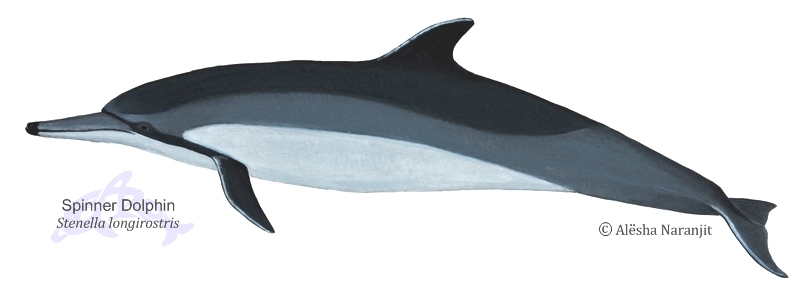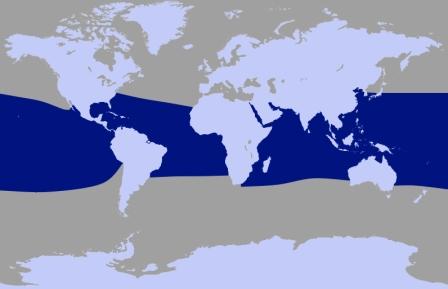
Classification Other Names: Long-snouted Dolphin, Long-beaked Dolphin, Spinner, Rollover Suborder: Odontoceti Family: Delphinidae | Description These animals are highly energetic and can leap up to 3m while performing the spins for which they were named (rotating around the longitudinal axis of the body). They readily bow-ride and do so longer than most dolphins. They generally hunt at night and rest in sheltered areas during the day.
|
Spinner Dolphin Ecology Range: Tropical and warm temperate waters with limits at 40ºN - 40ºS. Usual Habitat: Can be found both offshore and inshore Usual group size: Around 10 individuals, sometimes groups of 100s or 1000s Main Diet: Cheifly fish Local population: Unknown | Global range of the Spinner Dolphin  Dark blue areas indicate where Spinner Dolphins are likely to be found |
Protection and Conservation Status
IUCN Conservation Status: Spinner Dolphins are listed as "Data Deficient" on the IUCN red list. SPAW Protocol: Spinner Dolphins are cetaceans, which are listed under Annex II of the SPAW protocol. As such they require total protection under article 11 of this protocol which prohibits the "taking, possession, killing and commercial trade of the species, their parts or products". The SPAW protocol was created to help with the implementation and promotion of the Ramsar Convention and the Convention on Biological Diversity. The Annexes of the SPAW protocol can be found here. Local Laws: Cetaceans are protected under the Conservation of Wildlife Act of Trinidad and Tobago which offers protection to all species not listed under the second or third schedules of this act. |
This is currently being researched and written. It will appear here shortly.
References
The above information was obtained from the following sources:
- A Princeton Field Guide: Whales Dolphins and Other Marine Mammals of the World by Hadoram Shirihai and Brett Jarrett (2006)
- Smithsonian Handbooks: Whales Dolphins and Porpoises by Mark Carwardine and illustrated by Martin Camm (2002)
- The Whale and Dolphin Conservation Society's Species Guide at http://www2.wdcs.org/species/index.php
- The IUCN Redlist at http://www.iucnredlist.org
- The SPAW protocol Annexes with links available at http://www.car-spaw-rac.org/?Annexes-of-the-SPAW-Protocol,83
Acknowledgements
We would like to thank the following people for the use of the art work and photographs:
- Alësha Naranjit (Illustration of Spinner Dolphin)